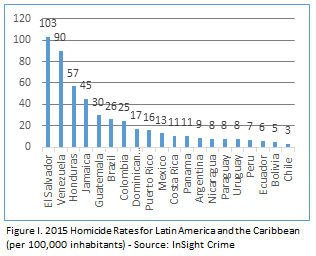
What's New
- Youth Violence Prevention in LAC: A Resource Guide for Aligning Indicators and Interventions to Deepen Impact
- Multisector Resource Guide for Preventing Youth Violence in Latin America
- Preventing Youth Violence in the LAC Region - Evidence and Gaps
- What Works to Prevent Lethal Youth Violence in the LAC Region: A Global Review of the Research
- Impact of Violence and Development in Central America’s Northern Triangle on Unaccompanied Alien Child (UAC) Migration to the United States
- Violence, Development, and Emigration: Evidence from Central American Children Detained in the United States
- Colombia Youth Violence Assessment Peer Research Report
- Honduras Gang Disengagement Study
- Guatemala Gang Disengagement Study
Prime Implementer
American Institutes of Research
Implementing Partners
Democracy International
Institute for Women's Public Research
Project Timeline
January 2017 - January 2022
Project Goal
LAC Youth Violence Prevention project’s overarching goal is to improve the capacity of USAID and its partners to successfully implement crime and violence prevention programming in the region.
Brief Background
Rates of crime and violence in Latin America and the Caribbean (LAC) region are some of the highest in the world. According to the 2014 United Nations Office of Drugs and Crime (UNODC) global study on homicides, the region is home to less than 8% of the world’s population but 37% of the world’s homicides. In some countries, such as El Salvador, Venezuela and Honduras, the rate of homicides has increased to epidemic proportions (Figure 1).

Young people are the principle victims and perpetrators of violence in the LAC region. The World Bank (2016) reports that the homicide rate in the region is 92 per 100,000 males aged 15-24, which is almost 4 times the regional average.
Additionally, women and LGBTI populations are frequently victims of violence in the LAC region. For example, depending on the country, between 17% to 53% of women have been victims of intimate partner violence during their lifetimes (IDB, 2016). And in a 15-month period from January 2013 to March 2014, 594 LGBTI persons were murdered and almost half were trans women (OAS, 2016).
Country and region-specific analyses are crucial to investigate drivers, risks, and protective factors of crime and violence. Programs implemented in LAC are not informed by more robust evidence on context-specific factors that may increase their effectiveness. To facilitate a full understanding of the factors that positively or negatively influence implementation of programs in the LAC region, implementers need better quality and access to evidence on interventions implemented in the same context.
Overview of Activities
The LAC-YVP project will pursue three approaches to improve USAID and other stakeholders’ capacity to design and implement youth violence prevention programming:
- Conduct regional analyses of crime and violence, including relevant drivers and risk factors. The project will increase information on crime and violence by carrying out a series of broad research activities. These may include an evaluation of USAID institutional capacity and learning needs, a stakeholder and program analysis, and country-level feasibility studies for specific interventions.
- Generate evidence on crime and violence prevention, with a particular focus on secondary and tertiary interventions. The project will evaluate interventions in order to increase the evidence base on the most effective programming to prevent crime and violence. Interventions to be evaluated may include existing programs in North America and/or the LAC region. Additionally, the project will also evaluate new programs, emphasizing secondary and tertiary interventions, to explore what works and what does not work (and why) to reduce youth violence.
- Disseminate evidence and information on what works to prevent crime and violence in LAC. The project will develop, compile, and make available resources to inform the design of more effective programs. Policymakers, practitioners and researchers will be able to access this information through various tools and knowledge exchange platforms such as conferences, e-newsletters, and policy briefs. The project will also facilitate communities of practice, including a regional Advisory Group of experts that will suggest new research efforts, ground-truth programmatic approaches, connect research to policy, and work collaboratively across ongoing USAID-funded programs, multilaterals, donors and cities for cumulative impact.
Project Approach
The project’s approach throughout will be to work interactively with stakeholders to reframe thinking about youth: from perpetrators and victims of violence toward necessary and valuable coalition members working to find solutions. Inclusion of youth voices in communities of practice will be a fundamental aspect of the project’s approach. To that end, LAC-YVP will engage young people to diagnose and analyze the problem of crime and violence in their communities, develop recommendations from their own perspectives, and promote dialogues with stakeholders.
A grants mechanism will be used to fund initiatives that aim to reduce youth violence and increase knowledge exchange. Grants will be issued throughout the life of the project to address specific needs that may include: testing of preventive interventions, developing resources and supporting other stakeholder`s activities to improve crime and violence prevention and positive youth development.
